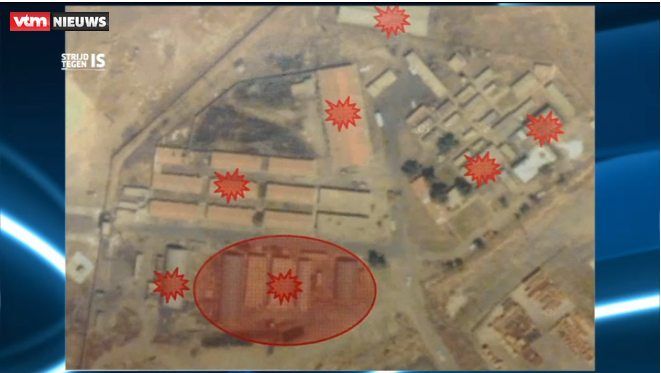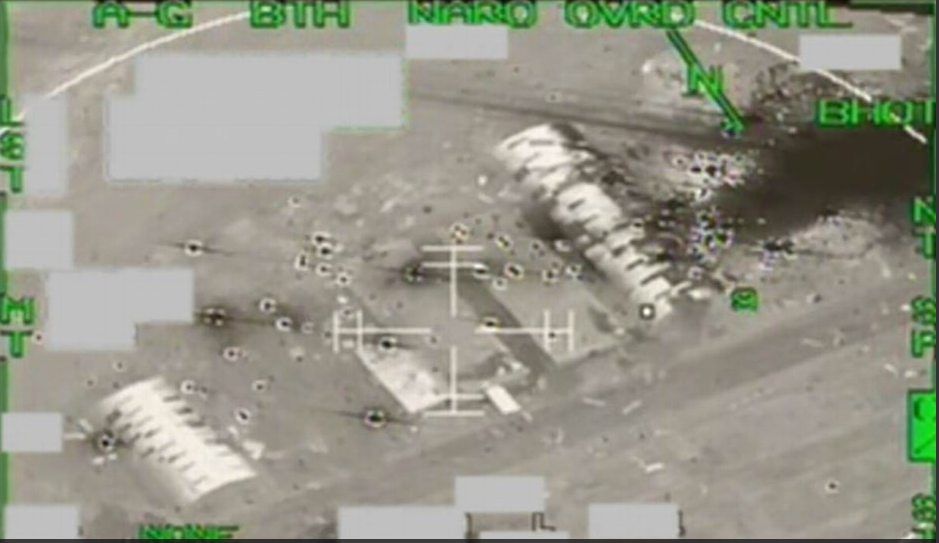This video comes right on the heels of the news of the Belgian Air Force CINC change of command, since Lt Gen Claude Vandevoorde has just been replaced by Major General Fred Vansina, until then Chief Operations. After some 6 years at the helm of the BAF, general Vandevoorde now works in an advisory capacity for the new Minister of Defence, Steven Vandeput.
In the video, general Vansina explains that since the beginning of October, the Belgian F-16 detachment has carried out 58 missions and in the process attacked or destroyed 18 Islamic State targets. The most notable mission thus far was a night attack on November 3 whereby two of our jets were leading 6 other coalition aircraft in an airstrike on an IS facility. The facility served as an IED factory and a place where pick-up trucks were converted into the kind of 'technicals' first seen in Somalia: armed with a heavy machinegun in the back and provided with some armour plating. The general stressed that no collateral damage was to be deplored (although how they verify that I have no idea).
This is the ISIS facility in question:

The first bozo who finds this on Google Earth gets 10 randomly picked Playboy centerfolds from Outlaw's Famous Collection. Hint: according to the Belgian Armed Forces website it's in Iraq's north.
Another image released last week by the MoD:

On 31 October, Defence Minister Vandeput claimed that the Belgian airstrikes "make up 12 per cent of the number of interventions by the international coalition". I have no way to verify this, but given the huge number of US missions I assume that by 'international coalition' he means only the non-US flights. Anyway, with a military that has been starved for decades by successive center-left governments (and alas, center-right ones too), this percentage would constitute no mean feat.
Remains of course the question of how useful the coalition's airstrikes are. I would wager that up until now they have been absolutely necessary. ISIS has profiled itself thus far as an organization preferring open warfare involving movement of armor, large-scale infantry assaults, the seizing of strategic objectives and so on. In other words, they have picked up the kind of fights we like: where they are visible and therefore present decent targets.
Their choosing this way of fighting has certainly been an advantage for the coalition. It is for instance clear that the siege of Kobani ultimately ended in disaster for IS because of the airstrikes. As long as they continue to expose their military hardware, we can degrade their fighting capability. While they may be getting the hint that it's better not to present such easy targets, I do not see how they can radically change this kind of warfare without abandoning their goals, since IS has apparently committed itself to militarily act like a nation state. If you want to add territory, oil infrastructure, airfields, highways etc to your inventory, you are going for a wholly different game of ball than, say, Saddamite diehards planting IED's in the Sunni Triangle ten years ago.
The airstrikes should therefore go on, but I see no reason to deploy western 'boots on the ground'. After ten years of building up the Iraqi Army, they should be able to fend for themselves. In 1972, the South Vietnamese were able to stop the NVA's Eastertide Offensive with the help from massive airstrikes conducted by both USAF and VNAF. In the three-month period of the beginning of April to the end of June, 27,745 missions were flown in support of the South Vietnamese Army (ARVN) - 20,506 of these by the US Air Force. To the best of my knowledge, these missions stand even apart from the ones conducted under the Linebacker Operation, which targeted Northern Vietnams strategic assets - airfields, bridges, ports, roads, railway systems etc. Just like the Iraqi Army, the South Vietnamese Army had been trained for a decade too, and they were able to stand their own. No 'boots on the ground' were needed any more. No boots on the ground should be needed this time. Of course South Vietnam did collapse a couple of years later, but that was because the Democrats had cut off funding. The US should be careful not to make the same mistake again.
Of course the nascent Iraqi Air Force can in no way be compared to the well-oiled war machine that the South Vietnamese Air Force was (at its peak, in 1974, it fielded 2,076 aircraft of all varieties). Of course the Iraqi Army itself is a joke compared to the ARVN. But then, in the same manner IS is but a laughable opponent compared to the North Vietnamese Army. Plus, the IA is helped in no small part by Kurdish forces in both Syria and Iraq, which divert considerable IS resources. And to put things in perspective, after all IS fields perhaps only some 30,000 ~ 40,000 ground 'troops' - give and take 3 divisions, and they haven't even organised them as such. Possibly there's only a loose scattering of combat groups under the command of the biggest braggers who happen to be around. There may be some kind of general HQ, but I cannot imagine it's in any way comparable to a western army's HQ.
The best way for the West to manage this is therefore to simply continue, and pound. And pound. And pound. And pound. Eventually IS will crack. As for the Belgian F-16 detachment, it will in all likelihood stay over Iraq in 2015. I hope the other contributing countries will do the same.
MFBB.
No comments:
Post a Comment